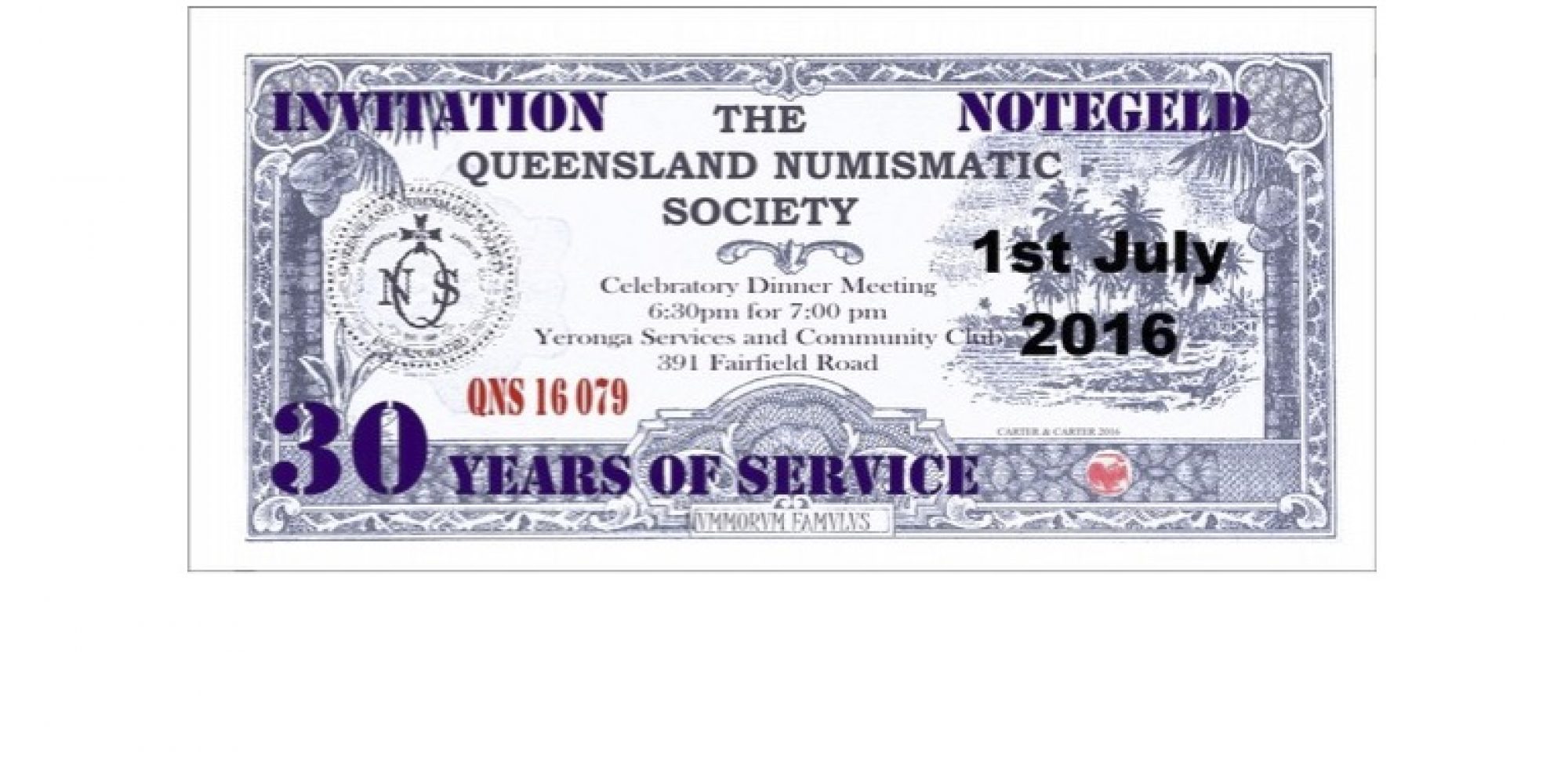Part 1
by Stephen Appleton
There are actually two distinct meanings for the word ‘bimetallic’, according to the dictionaries, and both can be related directly to numismatics:
- Consisting of two metals, often bonded together and having different rates of thermal expansion.
- Pertaining to the use of a monetary standard consisting of two metals, especially gold and silver, in a fixed ratio of value.
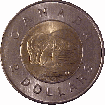
The first definition given above is what is commonly meant these days when a modern coin collector uses the word “bimetallic”. Few countries these days have not issued bimetallic coins – 117 bimetallic-issuing countries are listed on the website of the Worldwide Bimetallic Collector’s Club. This club claims a membership of over 280 (compare this to, say, the International Banknote Society (IBNS) with around 2200 members) and regularly publishes updates on new releases. Australia has been producing bimetallic coins since 1994 in the form of non-circulating 5 dollar coins. The relatively recent addition of ‘gold privy mark’ coins to the Perth Mint series also classify as bimetallic in this sense.
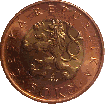
Bimetallic coins can look spectacular, but they worry me from a chemistry point of view. I was taught in university that whenever you place two dissimilar metals in contact in the presence of moisture, even humid air, accelerated corrosion is the inevitable result. (Something plumbers and ship-welders can tell you about!) I would assume that coin-issuing authorities would be aware of this principle and choose bimetallic alloys which are as compatible as possible, but I have noticed on some of my circulated bimetallic coins there are often ‘rings’ of discolouration around the contact area. Sometimes I wonder if archaeologists will find much evidence of these bimetallic coins in a thousand years time.

silver siglos
The second meaning is one more commonly encountered in older texts, and is the only meaning given in Doty’s Encyclopedic Dictionary of Numismatics. Historically, bimetallism is where the government or some such central authority fixed the price of gold relative to silver and then issued coins to match this proclamation. One of the earliest such coinages is the ancient Persian coinage. The Persians issued gold coins called darics and silver coins called sigloi. The daric and the siglos were the same size and were struck using the same dies (the daric was slightly heavier, as gold is denser than silver). The government then fixed the exchange rate at 20 sigloi to 1 daric. A more modern example of a bimetallic currency standard is the Latin Monetary Union, which saw the silver:gold ratio fixed at 15½:1.
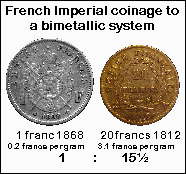 The bimetallic system’s primary flaw is that the true ‘market value’ of gold and silver fluctuates with time, as new sources of gold or silver are discovered and old ones become exhausted. Thus a government inevitably has to make a choice: maintain the ratio at its old, artificial level (unpopular with traders and merchants); re-evaluate the ratio at the new level (which can cause the public to lose faith in the currency) or abandon the bimetallic system in favour of the gold or silver (monometallic) standards. Of course, governments these days use neither.
The bimetallic system’s primary flaw is that the true ‘market value’ of gold and silver fluctuates with time, as new sources of gold or silver are discovered and old ones become exhausted. Thus a government inevitably has to make a choice: maintain the ratio at its old, artificial level (unpopular with traders and merchants); re-evaluate the ratio at the new level (which can cause the public to lose faith in the currency) or abandon the bimetallic system in favour of the gold or silver (monometallic) standards. Of course, governments these days use neither.
Part 2
by Frank Robinson
I read with interest the items, in the minutes of the January 2003 meeting, relating to bimetallic coins and also Stephen Appleton’s article on the same subject. I would like to add my tuppence worth, particularly as bimetallic coins are not a modern phenomenon. As Stephen points out, there is more than one way of defining “bimetallic”. The simplest definition I could find is in “The Macquarie Dictionary” which defines bimetallic as firstly “of two metals”. Using some lateral thinking, there have been various ways of combining two metals for use as coinage. (With one exception, electrum, I will disregard impurities in metals as constituting a bimetallic material.
Alloys
The earliest coins were an alloy of two metals – electrum which is a naturally occurring alloy of gold and silver. Later, many coins were struck from various man-made alloys of two or more metals; however as we are dealing with bimetallic coins, that limits us to alloys of two metals only. Some examples of bimetallic alloys are:
- brass [copper and zinc] – eg Roman sestertius and dupondius;
- silver alloys (pure silver was rarely used for coinage) [silver and copper] – eg ancient, medieval and modern coins;
- gold alloys (pure gold was rarely used for coinage) [usually gold and copper] – ancient, medieval and modern coins;
- pale gold alloy [gold and silver] – eg Sydney Mint sovereigns and half sovereigns;
- cupro-nickel [copper and nickel] used as a modern substitute for silver – eg Australian 5, 10, 20, and dodecagonal 50 cent coins.
Coatings and Plating
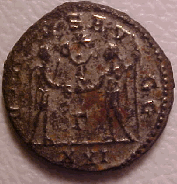
Another early method of producing bimetallic coins was to put a coating of one metal onto a core of another metal. This was often done to disguise a debased coinage, eg by using a copper core and “silver dipping” it. Rome first issued the antoninianus as a silver coin of 2 denarii, but only worth 1½ denarii. This coin was gradually debased and reached its lowest during the reign of Gallienus (253-68) when it was a copper coin with a thin silver coating which quickly wore off. This was possibly achieved by dipping the copper blanks in a silver nitrate solution so that some of the surface copper would be electrolysed and go into solution and silver metal would be deposited on the blank.
The later silver coins of Henry VIII of England were gradually debased until the last issue (1544-47) “silver” coins were struck from an alloy of one part silver and two parts copper (ie .333 fine). To make these coins appear to contain more silver than they actually did, the blanks were probably either silver washed (as above) or they may have been soaked in a weak acid solution to dissolve some of the surface copper. However, with wear from circulation, the richer silver surface was worn away, particularly on the high spots such as the king’s nose, and this led to his nickname of “old copper nose”.
A number of modern coins have also been plated, probably electroplated. Two combinations are:
- copper plated steel – eg West Germany 1 pfennig (1950-95);
- brass plated steel – eg West Germany 5 pfennig (1950-95), and 10 pfennig (1950-95).
Wedges
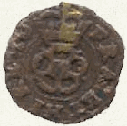
(from WBCC site)
During the reign of Charles I of England, a new series of royal farthing tokens was issued. These coins were made from a rod of copper with a wedge of brass that had been hammered into a groove that had been cut into the rod. Blanks were then sliced off the rod and the farthings struck from these blanks. As these pieces had a rose on the reverse (instead of a harp that had appeared on all the earlier issues of royal farthing tokens) they are usually referred to as rose farthing tokens. They were issued from 1636 until 1644 (when they were discontinued during the civil war). Thus these were bimetallic coins of copper with a brass wedge.
Plugs
After the restoration of Charles II of England, a major reform of the currency took place. This included the issue of copper halfpennies and farthings of full weight. However the price of tin had fallen placing the tin mines of Cornwall in crisis and the king, as the holder of the Duchy of Cornwall, was losing money. In order to help the tin industry (and the king’s finances), it was decided to strike all halfpennies and farthings from tin. To help prevent counterfeiting, a square copper plug was inserted in the centre of the blanks prior to striking. Thus these were bimetallic coins of tin with a copper plug and they were issued from 1684 until 1692 during the reigns of Charles II, James II, and William and Mary.
Patterns with Rings, Plugs, etc
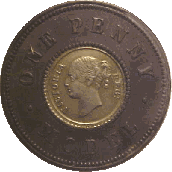
England also struck a number of bimetallic patterns. During the Commonwealth and the Protectorate (in the 1650s), and again during the reign of Charles II (particularly around 1665 and 1676), a significant number of patterns (both official and private) for base metal coinage were bimetallic. These pieces were struck from combinations such as copper with an inner brass ring, copper obverse and brass reverse, brass with a copper centre, tin with an inner brass ring, and tin with an inner copper ring. Again in William and Mary’s reign, trial pieces for a proposed coinage in “mixed metals” were struck (dated 1692) from copper with a tin centre and copper with a thin ring of brass let into either the obverse or reverse. However, in 1694, England reverted to copper for its base metal coinage. England appears to have then abandoned their bimetallic coinage experiments until 1844 when Joseph Moore (a Birmingham die sinker) produced his “model” pennies and halfpence. These were struck from copper with a white metal centre. They were a private proposal to replace the heavy copper coinage then in circulation.
Cladding

If two or more sheets or strips of metal are laid on top of each other with a sheet of high explosive above and below them, and the explosive is detonated, the sheets or strips of metal are welded together and appear (from the edge) to look like a sandwich. The resultant metal sandwich is then referred to as a “clad” metal and it can be worked in similar ways to other metals, including the various processes to make coins. The Federal Republic of Germany (ie West Germany) used several clad metal combinations for their coinage. Bronze clad steel was used for 1 pfennig (1948-49) and 2 pfennig (1967-95) coins. Brass clad steel was used for 5 pfennig (1950-95) and 10 pfennig (1949) coins. Cupro-nickel clad nickel was used for 2 deutsche mark (1969-95) and 5 deutsche mark (1975-95) coins. Russia (after the break-up of the USSR) used brass clad steel for their 1992 1 rouble and 5 rouble coins. Due to the rising price of silver in the mid to late 1960’s, the United States of America decided to stop using silver in their circulation coins and, from 1965, use a clad metal instead. They chose outer layers of cupro-nickel with a core of copper. Kennedy half-dollar coins (1965-70) and proof Eisenhower dollars were struck from a clad metal of two different silver alloys that had outer layers of .800 fine silver and a core of .209 fine silver giving a net content of .400 fine silver.
Outer Rings
Another type of bimetallic coin is where there is a large core of one metal with a ring (of another metal) around the core. This type of bimetallic coin has been increasing in use over the past decade. A few examples are:
- aluminium bronze centre in stainless steel ring – eg Australia 5 dollar (1996 Bradman);
- aluminium bronze centre in cupro-nickel ring – eg New Zealand 50 cent (1994);
- silver centre in gold ring – eg Austria 500 schilling (1995 Austrian membership of European Union);
- bronzital centre in acmonital ring – eg Italy 500 lire (1982-95);
Clad Centre with an Outer Ring
Another type of “bimetallic” coin is where there is a large clad core of three metals with a ring (of another metal) around the core. Although this is not actually a bimetallic coin, they appear to be, and are probably being considered (and collected) as bimetallic coins. The only examples that I am aware of are:
- nickel-brass clad nickel centre in cupro-nickel ring – eg European Union 2 euro (2002);
- cupro-nickel clad nickel centre in nickel-brass ring – eg European Union 1 euro (2002).
Bioraphy
Anthony, J, “Among the Ancients, Part XIII Valerian and Gallienus” in Coin Monthly, Vol 5 No 7, May 1971, United Kingdom
Brooke, GC, English Coins, Methuen, London, 3rd edn, 1962 reprint
Clain-Stefanelli, E & V, The Beauty & Lore of Coins, Currency & Medals, Riverwood Publishers, New York, 1974
Krause, CL, & Mishler, C; Bruce, CR (edit), 1998 Standard Catalog of World Coins, Krause Publications, Iola, USA, 25th anniversary edn, 1997
Milne, JG, et al, Coin Collecting, Oxford University Press, Oxford, United Kingdom, 1950
Peck, CW, English Copper, Tin and Bronze Coins in the British Museum 1558 – 1958, British Museum, London, 1st edn, 1960
Porteus, J, Coins, Octopus Books, London, 1973
Seaby, P & Purvey, PF (edit), Standard Catalogue of British Coins, Vol 1 – Coins of England and United Kingdom,Seaby, London, 17th edn, 1980
Sear, DR, The Emperors of Rome and Byzantium, Seaby, London, 1974
These articles first published in the January 2003 (part 1) and April 2003 (part 2) Magazines.
